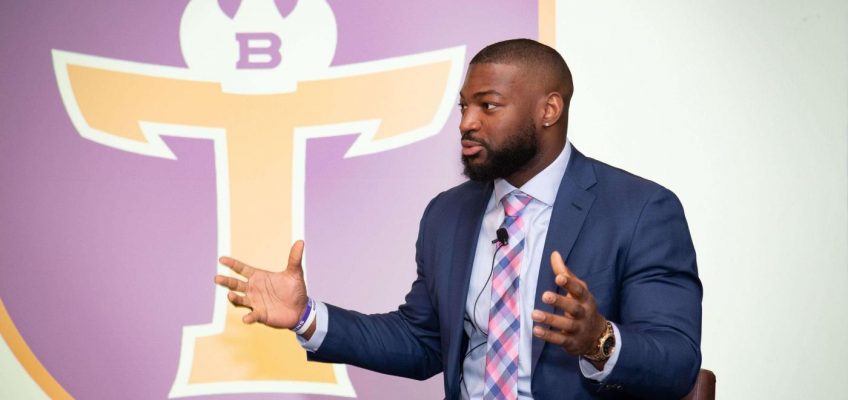One night after the Ravens beat their division rival Cincinnati Bengals, autographed helmets and jerseys of many of the team’s top players were available in a raffle at the top floor of the Hyatt Regency in the Inner Harbor.
Those who gathered bought raffle tickets, looked out over the Inner Harbor and mingled with Ravens linebacker Tyus Bowser, who recently launched an eponymous nonprofit aimed to help disadvantaged youth in Baltimore City.
The Tyus Bowser Foundation expects to host an event for teachers in early 2024, but first, the nonprofit kicked off with an event to raise money. The foundation hopes to:
Renovate unused classrooms in Baltimore middle schools into spaces that promote science, technology, engineering, mathematics and art.
Fund school supplies for teachers, rather than teachers spending their money.
Offer professional advice to high school students.
Bowser waited until he’d established himself in the NFL and received a second contract, he said, before launching the nonprofit. He was inspired in part by former Ravens teammate Calais Campbell, who was named Walter Payton Man of the Year in 2019.
“Just being able to impact kids, impact this community, especially being here for the last six years, I definitely want to give back just how they’ve been giving me,” Bowser told the Baltimore Sun.
The Texas native, who has not played this season due to injury, is in his seventh year with the Ravens. He wanted to start the nonprofit in Baltimore because “this is home to me,” he said.
Bowser has spent time helping his cousin, a teacher in Houston, prepare her classroom for the school year and noticed how much of their own money teachers spend on school supplies.
“When I say beyond proud, it’s an understatement,” said Bryana Jackson, his cousin, who attended the launch Friday in Baltimore. “I would fly in a New York minute just to come up here and help him. The young man that he has become, I’m extremely proud.”
Attendees at Friday’s “friends and family” kickoff event bought raffle tickets to win autographed merchandise from many Ravens: Lamar Jackson, Odell Beckham Jr., Zay Flowers, Gus Edwards, Mark Andrews, Roquan Smith, Patrick Queen, Kyle Hamilton, Geno Stone and Justin Tucker.
A signed baseball from Orioles All-Star Austin Hays, who sponsored a $20,000 scholarship for students in need earlier last year, was also a prize.
Funds raised from Friday will go toward a “teacher scramble,” allowing teachers to shop for their classrooms.
“Teachers go above and beyond for those kids and I just want to be that help for them so they don’t have to go out of pocket,” Bowser said.
Drafted by Baltimore in 2017, the 28-year-old Bowser started all 17 Ravens games in 2021 and notched seven sacks. He’s been sidelined by a knee injury, however, and has not played this season.
He told The Sun Friday night it’s been “a process,” but that he’s starting to see progress and hopes to return soon.
“My mindset is always to come back this year,” Bowser said.
“I don’t want to ever let any games go. But I’m also looking out for myself, just making sure I’m at my best. Because when I get on the field I make sure that I pour my heart out for my team, because I always put the team first before me.”
()




